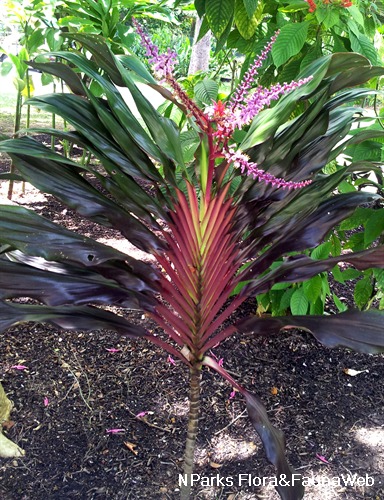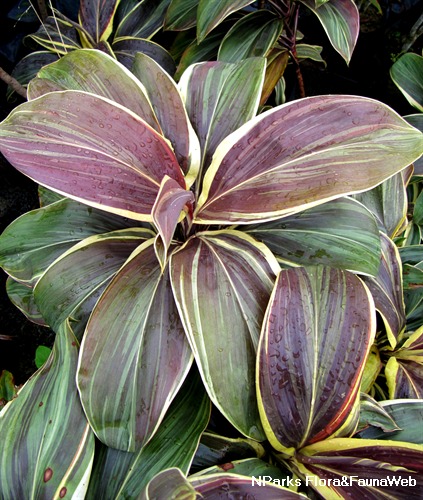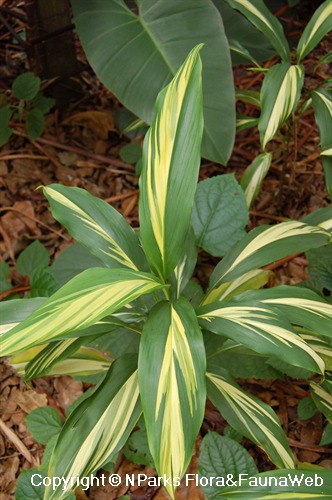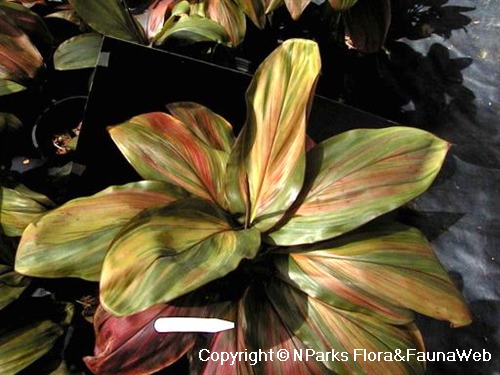
Back
Cordyline fruticosa 'Baby Ti'
| Family Name: | Asparagaceae |
| Common Name: | Ti Plant, Good Luck Plant, Cabbage Palm, Palm Lily |
Name
Classifications and Characteristics
| Plant Growth Form | Herbaceous Plant |
|---|---|
| Lifespan (in Singapore) | Perennial |
| Mode of Nutrition | Autotrophic |
| Plant Shape | Fountain (Palm-like) |
| Maximum Height | 0.6 m |
Biogeography
| Preferred Climate Zone | Tropical |
|---|
Description and Ethnobotany
| Others - Plant Morphology | Growth Form: Evergreen, rhizomatous shrub with a single, erect stem. Stem: Erect, single stem appears woody. Although the stem appears hard and dry, this cultivar is a monocot and therefore lacks true wood. The rhizome (underground, horizontal stem) is thick and resembles a tuber. Foliage: Smooth, glossy, thick leaves are leathery and strap-shaped with entire leaf margin, raised midrib and pointed leaf apex (30 - 76 cm long, 10 - 15 cm wide). Leaf blade is green with a thin, coppery red or bright magenta edge. The petiole and the underside of the midrib is also coppery red or bright magenta. They are spirally arranged near the top of a single, erect stem. Flowers: Small, fragrant flowers (1 cm wide) are arranged in branched clusters known as panicles (30 cm long). They are rarely produced indoors. Fruits: Fruit is a red, leathery capsule containing black seeds. Landscaping: This cultivar is planted for its ornamental foliage which provides a tropical look. It is attractive in mass plantings and could be used as a low maintenance ground cover that does not need to be continually divided. It is suitable for container plantings and is often grown indoors. Cultivation: This cultivar should be planted in fertile, well-draining soil. For container plantings, use a potting mix that is based on peat moss and does not contain perlite. Allow the top inch of soil to dry before rewatering and use only fluoride-free or low-fluoride water. Feed biweekly with a half-strength, 15-5-10 NPK fertilizer that contains micronutrients. Magnesium deficiency is a common problem among Ti plants which causes leaf yellowing, so make sure the fertilizer contains sufficient magnesium. It is susceptible to a variety of pests (eg., mealy bugs, aphids, spider mites, snails, slugs, nematodes and leafhoppers) and bacterial / fungal diseases caused by Cercospora, Phytophthora, and Xanthomonas species. Propagation: Propagate by stem cuttings, rhizome division and air layering. Etymology: The genus "Cordyline" is derived from the Greek word for club ("cordyle"), referring to the thick rhizomes of this genus. The species epithet "fruticosa" is derived from the Latin word for bushy ("fruticosus"). The cultivar name "Baby Ti" refers to its relatively short stature compared to other Cordyline cultivars. Caution: The leaves contain saponins which are toxic to dogs and cats. |
|---|
Landscaping Features
| Desirable Plant Features | Ornamental Foliage |
|---|---|
| Landscape Uses | Interiorscape/ Indoor Plant, General, Container Planting |
| Usage Hazard - Cons | Toxic Upon Ingestion |
Plant Care and Propagation
| Light Preference | Full Sun, Semi-Shade |
|---|---|
| Water Preference | Moderate Water |
Foliar
| Mature Foliage Colour(s) | Green, Red |
|---|---|
| Mature Foliage Texture(s) | Smooth, Glossy / Shiny, Leathery, Thick |
| Foliar Type | Simple / Unifoliate |
| Foliar Arrangement Along Stem | Spiral |
| Foliar Shape(s) | Non-Palm Foliage (Oblong) |
| Foliar Venation | Parallel |
| Foliar Margin | Entire |
| Foliar Apex - Tip | Acute |
| Foliar Base | Truncate / Square |
| Typical Foliar Area | Macrophyll ( 182.25cm2 - 1640.25 cm2 ) |
Non - Foliar and Storage
| Stem Type & Modification | Herbaceous |
|---|---|
| Root Type | Underground (Fibrous Root) |
| Specialised Storage Organ(s) | Underground (Rhizome) |
Floral (Angiosperm)
| Flower Size - Remarks | 1 cm wide |
|---|---|
| Inflorescence Type | Panicle |
Fruit, Seed and Spore
| Mature Fruit Colour(s) | Red |
|---|---|
| Fruit Classification | Simple Fruit |
| Fruit Type | Dehiscent Dry Fruit , Capsule |
Image Repository
Others
| Master ID | 29373 |
|---|---|
| Species ID | 3682 |
| Flora Disclaimer | The information in this website has been compiled from reliable sources, such as reference works on medicinal plants. It is not a substitute for medical advice or treatment and NParks does not purport to provide any medical advice. Readers should always consult his/her physician before using or consuming a plant for medicinal purposes. |







